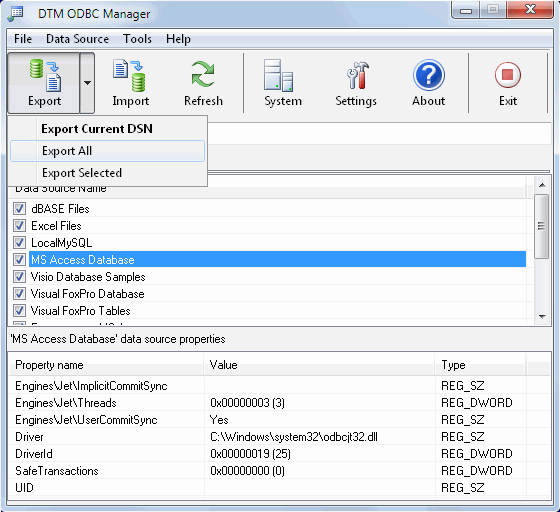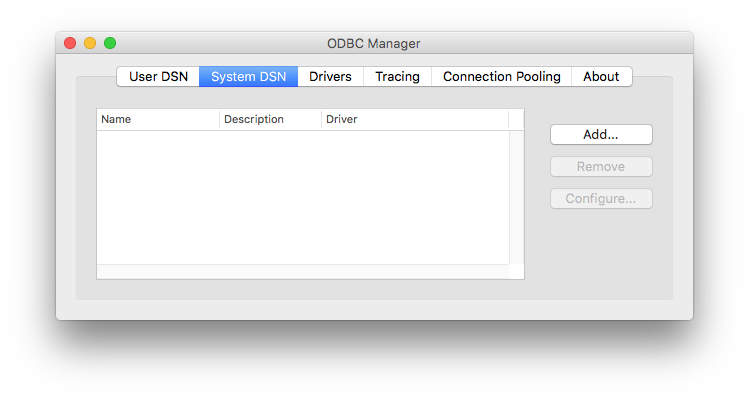

- #ODBC MANAGER NOT CREATING USER DSN HIGH SIERRA HOW TO#
- #ODBC MANAGER NOT CREATING USER DSN HIGH SIERRA DRIVERS#
- #ODBC MANAGER NOT CREATING USER DSN HIGH SIERRA DRIVER#
- #ODBC MANAGER NOT CREATING USER DSN HIGH SIERRA MANUAL#
- #ODBC MANAGER NOT CREATING USER DSN HIGH SIERRA WINDOWS 7#
#ODBC MANAGER NOT CREATING USER DSN HIGH SIERRA DRIVER#
#ODBC MANAGER NOT CREATING USER DSN HIGH SIERRA HOW TO#
Configure data sources These topics explain how to configure a data source (DSN) on UNIX™ and Windows™ for HCL® OneDB® ODBC Driver.The topics also describe conformance, isolation and lock levels, libraries, and environment variables. Overview of HCL OneDB™ ODBC Driver These topics introduce the HCL® OneDB® ODBC Driver and describe its advantages and architecture.
#ODBC MANAGER NOT CREATING USER DSN HIGH SIERRA MANUAL#
The HCL OneDB™ ODBC Driver Programmer's Manual serves as a user guide and reference for HCL® OneDB® ODBC Driver, which is the HCL OneDB™ implementation of the Microsoft™ Open Database Connectivity (ODBC) interface, Version 3.0. HCL OneDB™ ODBC Driver Guide These topics serve as a user guide and reference for HCL® OneDB® ODBC Driver, which is the HCL OneDB™ implementation of the Microsoft™ Open Database Connectivity (ODBC) interface, Version 3.0.The HCL® OneDB® GLS User's Guide describes the Global Language Support (GLS) feature available in HCL® OneDB® products. GLS User's Guide These topics describe the Global Language Support (GLS) feature available in HCL® OneDB® products.The HCL® OneDB® ESQL/C Programmer's Manual explains how to use HCL OneDB™ ESQL/C, the HCL OneDB™ implementation of Embedded Structured Query Language (SQL) for C (ESQL/C), to create client applications with database-management capabilities. ESQL/C Guide The topics explain how to use HCL OneDB™ ESQL/C, the HCL OneDB™ implementation of Embedded Structured Query Language (SQL) for C (ESQL/C), to create client applications with database-management capabilities.The HCL® OneDB® Change Data Capture API Programmer's Guide describes how to program applications to process changed data from HCL OneDB™ databases using the HCL® OneDB® Change Data Capture API. Change Data Capture API Programmer's Guide These topics describe how to program applications to process changed data from HCL OneDB™ databases using the HCL® OneDB® Change Data Capture API.Client APIs and tools You can use the HCL OneDB™ implementation of client APIs to develop applications for HCL OneDB™ database servers.Here is a table that shows which ODBC Administrator Tool to use: Windows OSĦ4-bit ODBC Administrator tool %systemdrive%\Windows\System32\odbcad32.exe, or Control Panel\System and Security\Administrative Tools\Data Sources (ODBC)ģ2-bit ODBC Administrator tool %windir%\SysWOW64\odbcad32.exeģ2-bit ODBC Administrator tool %systemdrive%\Windows\System32\odbcad32. Note: All Office versions prior to Office 2010 can only be installed as 32-bit applications. Underneath "About Microsoft Excel", you will see a version number and in parentheses 32-bit or 64-bit will be listed.Click on the File tab in the upper left corner.To determine whether Office 2010 64-bit or 32-bit is installed, take the following steps:
#ODBC MANAGER NOT CREATING USER DSN HIGH SIERRA DRIVERS#
The second ODBC Administrator tool to manage the 32-bit drivers and DSNs on the machine can be launched from the SysWow64 folder. The 64-bit ODBC Administrator tool is the default dialog that is launched from the control panel and is used to manage the 64-bit drivers and DSNs on the machine. On a 64-Bit Windows operating system, there are two versions of the ODBC Administrator tool.
#ODBC MANAGER NOT CREATING USER DSN HIGH SIERRA WINDOWS 7#
For example, the default location on a Windows 7 64-bit machine is "C:\Windows\SysWOW64\odbcad32.exe". If you build and then run an application as a 32-bit application on a 64-bit operating system, you must create the ODBC data source by using the ODBC Administrator tool in %windir%\SysWOW64\odbcad32.exe.

To locate the 32-bit Office System drivers, use the appropriate version of the ODBC Administrator tool. In 64-bit versions of Windows, there is a separate ODBC Administrator used to manage 32-bit drivers and DSNs. This occurs when the 32-bit version of Office or the 32-bit Office System Drivers is installed on a 64-bit version of Windows. They are not visible in the standard ODBC Administrator dialog that is launched from the Administrative Tools dialog in the Control Panel. When attempting to create ODBC connections that utilize the Microsoft Office System Driver, such as connections to Access or Excel, on a 64-bit Operating system like Windows 7, the drivers are not visible.


 0 kommentar(er)
0 kommentar(er)
